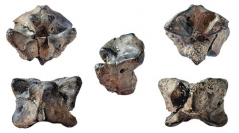

 Comptes Rendus Palevol
18 (7) - Pages 771-781
Comptes Rendus Palevol
18 (7) - Pages 771-781Madtsoiids constitute a successful group of extinct snakes widely distributed across Gondwana and the European archipelago during Late Cretaceous times, surviving in reduced numbers to the Pleistocene. They are renowned for including some of the largest snakes that have ever crawled on earth, yet diverse small madtsoiids are also known. Uncovering the evolutionary trends that led these snakes into disparate body sizes has been hampered mainly by the lack of phylogenetic consensus and the paucity of taxa with novel combinations of features. Here we describe a new large madtsoiid snake based on isolated vertebrae from the La Colonia Formation (Maastrichtian–Danian) of Patagonia, Argentina. A comprehensive phylogenetic analysis recovers Madtsoiidae as a basal ophidian lineage and the new snake as sister to a clade of mostly big-to-gigantic taxa, providing insights into early stages and evolutionary trends towards madtsoiid gigantism.
Ophidia, Serpentes, Madtsoiidae, phylogenetics, La Colonia Formation